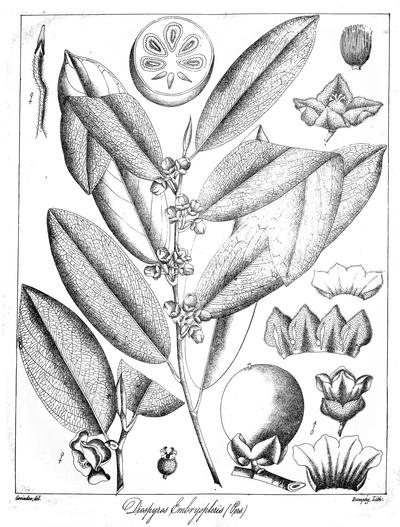Gaub Tree
(Diospyros embryopteris)
Gaub Tree (Diospyros embryopteris)
/
/

Govindoo
Public domain
Image By:
Govindoo
Recorded By:
Copyright:
Public domain
Copyright Notice:
Photo by: Govindoo | License Type: Public domain | License URL: https://creativecommons.org/public-domain/ | Uploader: Shyamal | Publisher: Wikipedia Commons


Estimated Native Range
Summary
Diospyros embryopteris, commonly known as the gaub tree, Malabar ebony, black-and-white ebony, or pale moon ebony, is an evergreen tree that is native to the moist deciduous forests and rainforests of the Indian Subcontinent and Southeast Asia. It is a slow-growing species that can reach up to 115 feet in height, with a distinctive black trunk that may grow up to 28 inches in diameter. The canopy is dense, providing significant shade, and the leaves are glossy, adding to its ornamental value. The tree produces small, bell-shaped, creamy-white flowers that are inconspicuous. The flowering season is typically in the spring, and while the flowers are not particularly showy, they are followed by round, yellow fruits when ripe, which are often astringent and not widely eaten.
The gaub tree is valued for its hard, dense wood, which is used in fine cabinetry and specialty wood products. It is also appreciated for its medicinal properties in traditional Ayurvedic medicine and has a history of being used to dye cloth black. In cultivation, it requires a moist, well-drained soil and can tolerate a range of light conditions from full sun to part shade. It is not commonly used in urban planting due to its large size but may be found in botanical gardens and large estates. Gardeners should be aware that it can take many years to reach maturity.CC BY-SA 4.0
The gaub tree is valued for its hard, dense wood, which is used in fine cabinetry and specialty wood products. It is also appreciated for its medicinal properties in traditional Ayurvedic medicine and has a history of being used to dye cloth black. In cultivation, it requires a moist, well-drained soil and can tolerate a range of light conditions from full sun to part shade. It is not commonly used in urban planting due to its large size but may be found in botanical gardens and large estates. Gardeners should be aware that it can take many years to reach maturity.CC BY-SA 4.0
Plant Description
- Plant Type: Tree
- Height: 20-30 feet
- Width: 10-15 feet
- Growth Rate: Moderate
- Flower Color: Green
- Flowering Season: Spring
- Leaf Retention: Evergreen
Growth Requirements
- Sun: Full Sun, Part Shade
- Water: Medium
- Drainage: Medium, Fast
Common Uses
Bee Garden, Bird Garden, Edible*Disclaimer: Easyscape's listed plant edibility is for informational use. Always verify the safety and proper identification of any plant before consumption., Low Maintenance
Natural Habitat
Moist deciduous forests and rainforests of the Indian Subcontinent and Southeast Asia
Other Names
Common Names: Malabar Ebony, Indian Persimmon
Scientific Names: , Diospyros embryopteris,
GBIF Accepted Name: